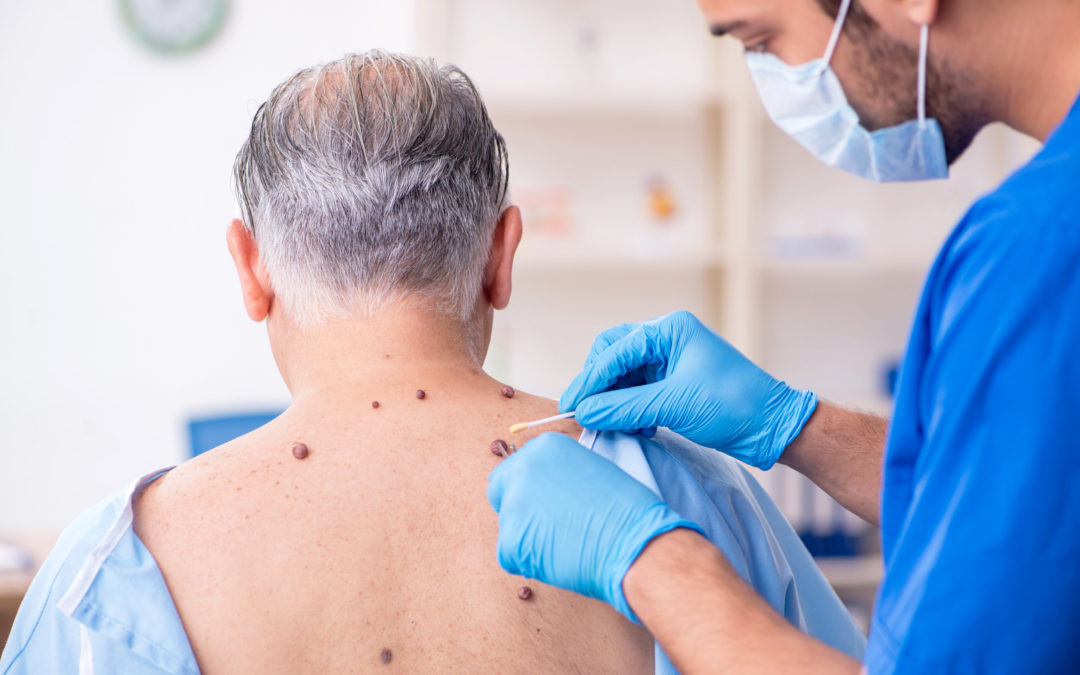Skin growths can be defined as either benign or malignant. A benign growth is non-cancerous, typically develops slowly, and doesn’t spread to other parts of the body. A malignant growth, on the other hand, is cancerous, can grow rapidly, and, in some cases, can spread to tissues in other parts of the body.
If you have a skin growth, you may be wondering if it’s something to worry about. Here, we’ll discuss common malignant and benign skin growths so that you can learn more about the topic.
Remember to have regular skin checks if you’re at risk for skin cancer. A light natural skin tone, blond or red hair, green or blue eyes, having a large number of existing moles, a family or personal history of skin cancer, and advanced age are all risk factors for skin cancer. To protect yourself against the risks of malignant skin growth, schedule a skin exam today.
Malignant Skin Growths:
-
Melanoma
Melanoma is a malignant skin growth that can be very severe. The most common presentation of melanoma is a new, abnormal growth on the skin or changes in a mole that you already have. Melanomas are often asymmetrical, have an uneven border, or have multiple colors. Previous guidelines suggested that size was also a risk factor, specifically if the lesion was more than 6 millimeters in size. However, the general feeling now is that even if a lesion is not that large, it should be evaluated if it has the other suspicious features listed above.
-
Squamous cell carcinoma
Squamous cell carcinoma (SCC) is a much more common type of skin cancer that’s not as familiar to most people. It generally appears as a flat, scaly patch of reddish skin. While SCC is often completely curable when it’s diagnosed early, it can become quite dangerous if it’s allowed to progress and grow in size. In these cases, it can even become life-threatening, especially in at-risk populations (such as organ transplant recipients). In fact, since it is so much more common than melanoma, more people die each year from SCC than from melanoma.
-
Basal cell carcinoma
Basal cell carcinoma (BCC) is the most common type of skin cancer. It often appears as a shiny bump that’s red, pink, or white; a pink growth with a rolled edge and indentation; or a scar-like portion of the skin that’s white or yellow. Eventually, it will progress to become an open sore that doesn’t ever completely heal. While it’s true that BCC very rarely progresses to the point of becoming life-threatening, it’s often so small or otherwise hard to recognize that it can go undiagnosed for months or even years. In that time, it can cause significant damage to surrounding structures.
Benign Skin Growths
Some of the most common benign skin growths include:
-
Skin tags
A skin tag is a non-cancerous skin growth. It’s a small piece of soft skin that may have a stalk, called a peduncle. Skin tags are very common and completely harmless.
-
Seborrheic keratoses
This benign skin growth generally appears as a plaque that’s brown, scaly, and potentially greasy. While this growth isn’t dangerous, it may be itchy and inflamed, which often requires treatment.
-
Lipoma
A lipoma is a fat tumor that grows slowly and can become as large as 10 cm or more. While lipomas don’t generally cause symptoms, they may become painful if they put pressure on a nerve. Lipomas that require treatment are typically removed using excision.
If you have any skin lesions that are new, look suspicious, or that you’re concerned about, don’t hesitate to contact The Bowman Institute for an appointment. Also, if you have only one lesion that you’re concerned about, give us a call and let us know. We can usually see patients the same day or the next day to evaluate single lesions.

